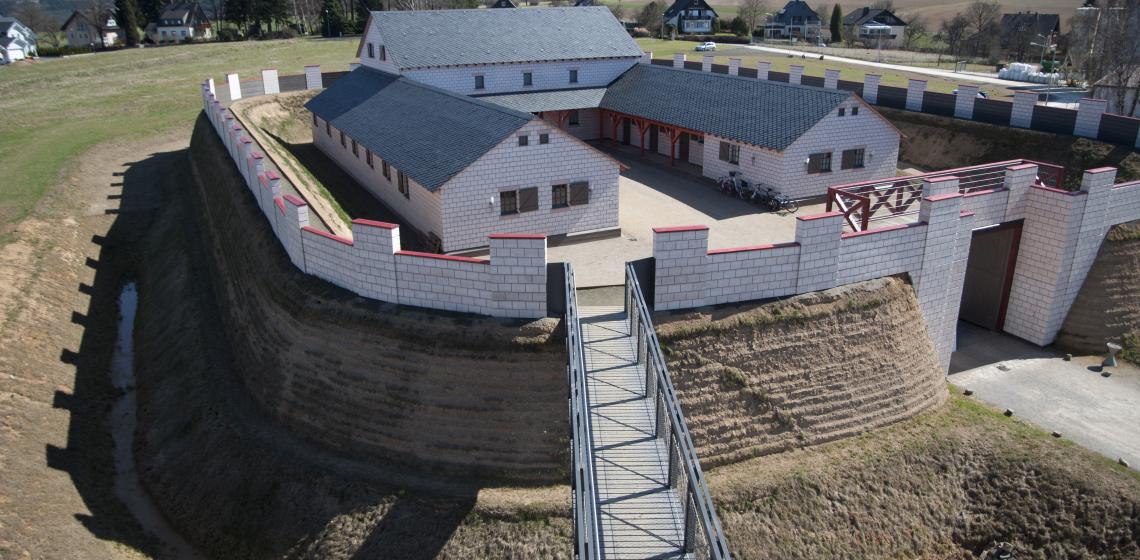Limeskastell Pohl (DE)

Trajan's column in Rome and Replica of a Roman Fortlet and Watchtower at Pohl on the UNESCO World Heritage Site „Frontiers of the Roman Empire" by Dr. Jens Dolata, archaeologist at the Head Office for Cultural Heritage (GDKE) Rhineland-Palatinate at Mainz.
The dedication of Trajan's Column in Rome took place 1900 years ago, attested by the Fasti Ostienses in a ceremony lasting from May 10th to 12th 113. The 40 meter high monument carries a 200 meter spiral frieze depicting the development of a section of the Roman Imperial Frontier in 155 scenes with 2000 carved figures. Emperor Trajan completed with this enormous victory monument and war report his outstanding forum in the Urbs Roma.
About the same time there was built the Limes (pronounced LEE-mays) and with it a small fortlet of timber and earth in the northern forest of Mons Taunensium by the Roman army. The Upper German-Raetian Limes protected the northern land border of the Roman Empire between AD 85 and about AD 260. Starting as a simple cleared strip through the forest, it went on to become a continuous and fortified frontier of considerable architectural distinction. More than 900 watchtowers, numerous fortlets and some 60 large forts were built over a distance of 550 kilometres. This Limes did not serve purely military purposes; it also offered protection for trade routes and trading posts. lt brought a period of relative peace to its hinterland which lasted about 150 years.
The small Taunus community of Pohl has developed an open-air museum opened to public on October 1st 2011. The „Limeskastell-Pohl" is running as a supra-regional museum of the highest level for presenting the concerning UNESCO World Heritage Site. A specialized archaeologist is responsible for the quality and authenticity of the performance. Main emphasis of presentation in Pohl cover military history, frontiers of the Empire and Limes architecture.
Three scenes are connected by the historical story told at Pohl: Urbs Roma — the capital of Empire and residence of the Emperor. Traianus gave the order to protect the northern frontier. At Mogontiacum have been the headquarters of the Legatus Augusti Pro Praetore Germaniae Superioris, the governor of the Upper Rhine Province, who was responsible for the area concerning to Roman Mainz. His legions and auxilia built the northern part of the Limes. How this was going on at another frontier of the Empire on river Danube is shown to the citizens of Rome on Trajan's column. The ancient blueprint for the replica structures of the Limes fortlet and watchtower at Pohl can be found in Rome.
The Upper German-Raetian Limes was inscribed in 2005 by UNESCO as part of an international World Heritage Site. 550 kilometres are only a small part of a coming transnational serial World Heritage Site covering 5500 kilometres in three continents.
Today are inscribed two other sections: Hadrian’s Wall in England and the Antonine Wall in Scotland. Several other countries are preparing their membership. Some of the most important historical reconstructions and rebuildings along the Limes are situated in the most northern part of Limes in Rhineland-Palatinate. The earliest reconstruction of a watchtower on the Bad Ems Wintersberg was built in 1874. Not far away, in Pohl, the visitor can experience a unique historic site, complete with ramparts, fortlet buildings and watchtower, presenting the state of research of today. The presentation of Limes in Pohl means best practice for imparting visitors the outstanding universal value (OUV) of the Limes as heritage of mankind.
The Limes with its forts, fortlets, towers, walls, banks, ditches, palisades, linked infrastructure and civilian architecture exhibits an important interchange of human values through the development of Roman military architecture, extending the technical knowledge of construction and management to large areas of the world. In general, and along the inscribed sections in particular, the Limes bears an exceptional testimony to the Roman culture and its different traditions ‒ from military, through engineering, architecture, religions, management and politics. In addition it triggered the exchange of cultural values through movement of soldiers and civilians from different nations.
The Roman Limes, and its German section, are an outstanding example of military architecture and building techniques, which were spread all around Europe and parts of Asia and Africa.
This is what can be learned at Pohl.
We invite You to visit Pohl and to be participator of the fascinating Roman Cultural Heritage in Rhineland-Palatinate. Get your archaeological experience in Pohl.
For further information: contact to author, who is curator for the fortlet in Pohl: jens.dolata@gdke.rlp.de Generaldirektion Kulturelles Erbe Rheinland-Pfalz, Direktion Landesarchäologie, Außenstelle Mainz, Große Langgasse 29, D ‒ 55116 Mainz.
